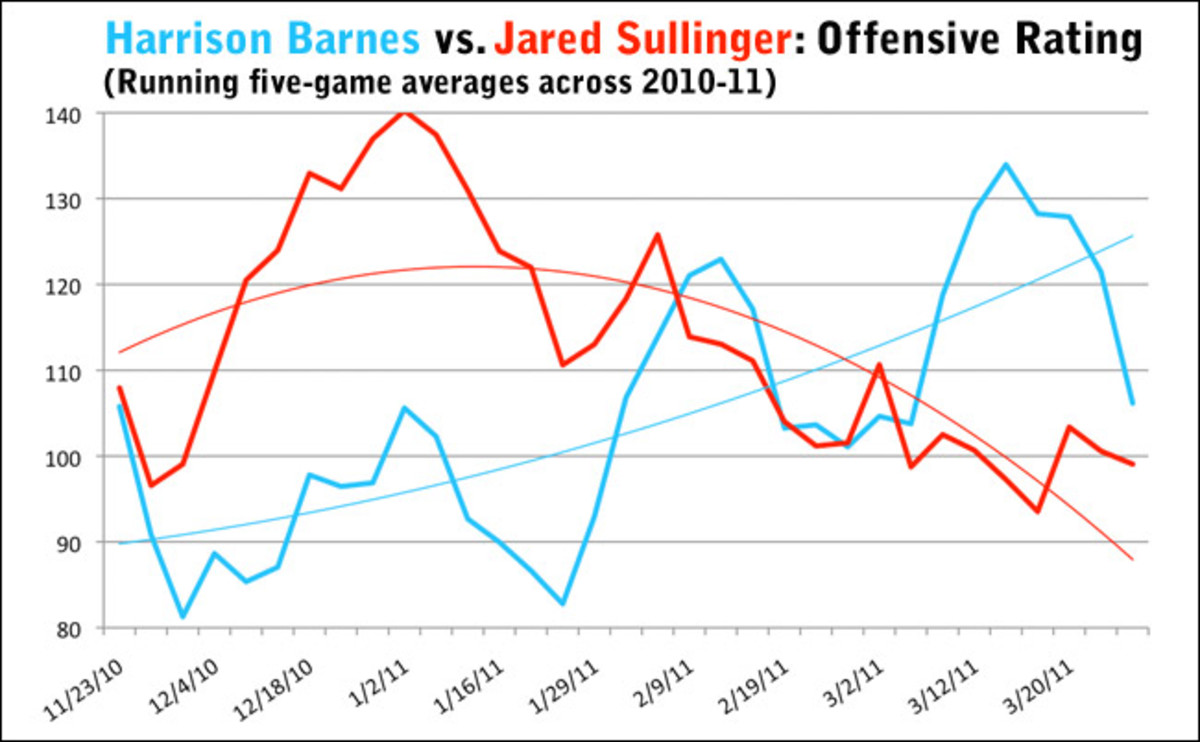
Barnes' return completes Carolina coup, makes Heels No. 1 in '11-12
It was enough to make the Tar Heels my provisional No. 1 on April 5, and it turns out it wasn't just wishful thinking. On Monday, with Barnes' announcement that he was returning for his sophomore year, they pulled off the coup of keeping all the major parts together from this season's Elite Eight team, meaning that they're likely to officially begin the 2011-12 season at No. 1. (Kentucky could make its own case if Knight and Jones pass on the draft, but that would be an even bigger coup.)
Barnes' decision stands out in the context of his highly-rated peers; as was pointed out on Twitter, he's the first player in the last five years who didn't go one-and-done after being ranked in the top four on Scout and Rivals.com's prospect lists. But Barnes has a strong family situation and didn't need to rush into his first pro contract, a la Selby. Barnes could consider the big picture, and realize that he'd leave no legacy at Carolina if he left after one season, despite the fact that he was a projected top-five pick.
As a business major with a mindset that's as much MBA as it is NBA, Barnes knows full well that his personal brand would be enhanced by a national title -- particularly one that comes exactly 30 years after the Tar Heels won it all with Michael Jordan, the player Barnes' mother, Shirley, had him model himself after as a kid. Last summer, Barnes said that he viewed college, at the very least, as a "networking opportunity," and a championship would forever link him with UNC's legends. An immediate jump to the pros would have made him only a Brandan Wright-esque afterthought.
Now that Barnes is officially back, here are four thoughts on the 2011-12 Tar Heels:
1. If Barnes picks up where he left off this March, he should give Ohio State's Jared Sullinger a run for National Player of the Year honors. Barnes' early struggles were well-chronicled, while Sullinger was a beast from Day 1, but a side-by-side examination of their freshman seasons reveals two very different trajectories.
First, let's look at the trendlines of their respective offensive efficiency ratings (essentially points per possession) across 2010-11. The chart below shows each player's running five-game average from November-March, with a polynomial trendline. Barnes makes a significant surge in the last two months, while Sullinger is trending downward:
Barnes' surge is even more impressive when you consider that he was taking on an increasingly larger role in Carolina's offense down the stretch. This second chart compares running five-game averages of the percentage of team shots taken by each player. Sullinger's usage rate stays relatively flat around 25 percent, but Barnes' trends into the 30s:
2. This Tar Heels team could set a draft record. At best, they can tie the record held by '99 Duke and '05 Carolina for four lottery picks from one team -- Barnes, Henson, Zeller and James McAdoo are all in DraftExpress.com's 2012 lottery. But they have a chance to put six players in the first round, breaking the mark set by Kentucky in '10, if point guard Kendall Marshall and two-guard Reggie Bullock elevate their draft stock with big performances in a national-title run. They're both currently viewed as fringe first-rounders, and Bullock has much to prove after an injury-shortened rookie campaign.
3. If you thought the Carolina frontcourt was good last season, with Barnes-Henson-Zeller as the 3-4-5, it's only going to get better once 6-foot-8 freshman McAdoo is added to the rotation. He's a highly developed power forward who can play the 4 or 5 spots, and doesn't need much seasoning; DraftExpress' Jonathan Givony has called McAdoo a college version of Tim Duncan, and says that while Barnes is still the bigger NBA prospect at present, "McAdoo is not that far behind him." Both players could go in the top five in 2012.
4. The Heels do have some flaws, the first being that they were a subpar free-throw shooting team last season, ranking 236th nationally, at 67.2 percent. Henson's 47.9 percent is the most glaring problem, but an equally bigger issue is that the guy they'll like to have handling the ball in late-game situations, Marshall, shot just 69.0 percent as a freshman. For comparison, the lead guard in this year's title game, Kemba Walker, shot 81.9 percent from the stripe.
This Carolina crew is also questionable from long range. Roy Williams' '05 title team ranked seventh nationally in three-point percentage, and his '09 team ranked 24th, while the '10 Tar Heels ranked 248th, at 32.8 percent. Bullock, who was hailed as a big-time shooter as a recruit, hit just 29.6 percent and needs to step up. If they're hurting for long-range marksmen, freshman P.J. Hairston could serve as an instant-offense option off the bench. Scouting reports project him as the kind of gunner who can connect at a 40 percent clip, and on a team with a less-loaded roster, Hairston would be an immediate starter with a double-digit scoring average. For these Heels, he'll have to be content as a role player. Such is the trade-off when you're chasing a championship.




